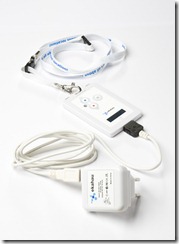A Wi-Fi-based clinical observation thermometer appears on the scene
Article – From the horse’s mouth
Solwise
http://www.solwise.co.uk/wireless-cadisense.htm
CadiSense
My Comments
There have been some trends taking place to make the home network become part of in-home health care. One of the previous trends was Fujitsu using a digital camera like what is equipped in a smartphone or Webcam as a tool for measuring your pulse. Similarly, another company implemented a set of urinalysis “control sticks” that can be assessed not through a reference chart on the packaging but by a platform smartphone app that uses the phone’s camera to read these sticks.
Now a device has been launched in the UK through Solwise which uses a wireless temperature sensor to provide continual body temperature monitoring using the home network. This device, known as “Cadisense” implements a wireless temperature sensor that attaches to the patient’s nappy (diaper) or undergarment and touches the lower abdomen to measure the temperature. This device sends these temperature readings to a plug-in network bridge that connects to your home network via Wi-Fi or Ethernet, with the network bridge keeping a long-term record of these observations that are taken every 30 seconds.
The data can be viewed on a Web server integrated in the network bridge that is accessible through the home network or via a remote link like what is used for most network devices that implement “remote access” or “cloud” functionality. The “dashboard” Website hosted by this Web server is optimised for viewing on a regular computer, tablet or smartphone and has the ability for regular-computer users to download the observations to the hard disk as a CSV file to import in to a spreadsheet application or email to their doctor. There are also the mobile-computing apps that work tightly with the iOS and Android platforms
At the moment, this device is focused towards observation-based clinical temperature measurement but shows that this concept can be proven beyond this application. There is a current limitation where the Cadisense temperature sensors can only work with the supplied network bridge but it is made up for the fact that the network bridge is a “3-way” wireless network device that can be either a Wi-Fi client bridge, a Wi-Fi range extender or an infill Wi-Fi access point.
For that matter, Cadisense are on a good wicket with their design because they could work this platform for a lot of in-home health-care applications including “ageing at home”. For example, their network bridge could come in to its own with the Ekahau Wi-Fi Pager Tags to be the core of a network-based “emergency-call” system that is a necessary part of caring for older people.
Once a system like this is built around industry-accepted standards like Z-Wave or Zigbee, it could mean a lot more for at-home health care and wellness applications amongst other applications like security and home automation.

